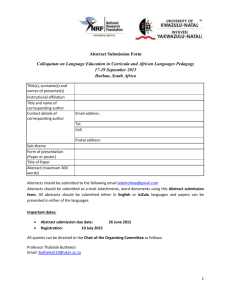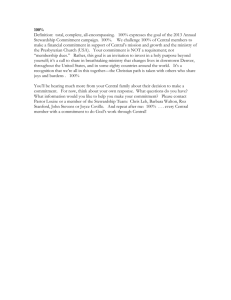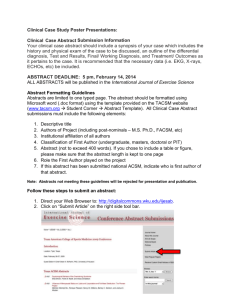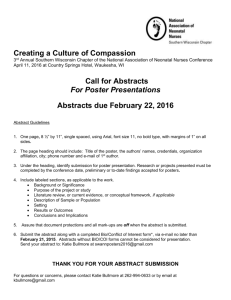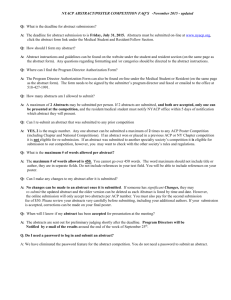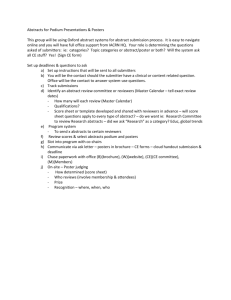UESC 2015 Poster Submission Abstracts "Urban environmental
advertisement
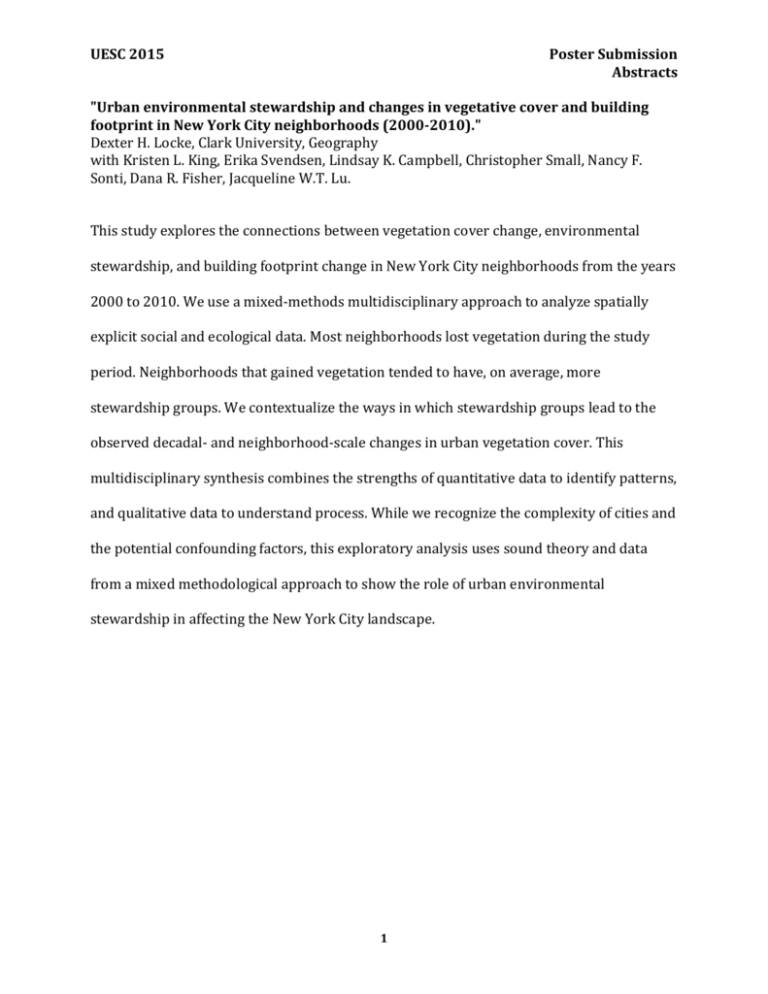
UESC 2015 Poster Submission Abstracts "Urban environmental stewardship and changes in vegetative cover and building footprint in New York City neighborhoods (2000-2010)." Dexter H. Locke, Clark University, Geography with Kristen L. King, Erika Svendsen, Lindsay K. Campbell, Christopher Small, Nancy F. Sonti, Dana R. Fisher, Jacqueline W.T. Lu. This study explores the connections between vegetation cover change, environmental stewardship, and building footprint change in New York City neighborhoods from the years 2000 to 2010. We use a mixed-methods multidisciplinary approach to analyze spatially explicit social and ecological data. Most neighborhoods lost vegetation during the study period. Neighborhoods that gained vegetation tended to have, on average, more stewardship groups. We contextualize the ways in which stewardship groups lead to the observed decadal- and neighborhood-scale changes in urban vegetation cover. This multidisciplinary synthesis combines the strengths of quantitative data to identify patterns, and qualitative data to understand process. While we recognize the complexity of cities and the potential confounding factors, this exploratory analysis uses sound theory and data from a mixed methodological approach to show the role of urban environmental stewardship in affecting the New York City landscape. 1 UESC 2015 Poster Submission Abstracts "Engagement in, potential for, and barriers to stewardship among New York City park users." Lindsay K. Campbell, US Forest Service with Erika S. Svendsen, Michelle L. Johnson, and Novem Auyeung Urban natural resource managers are increasingly interested in cultivating public engagement in caring, maintaining, and advocating for parks and natural areas. While large scale, destination parks such as Central Park, Prospect Park, and the High Line often have a well-organized cadre of volunteer stewards organized through park conservancies and coalitions, the majority of urban parks lack the formal organizational structure or dedicated parks organizers to transform the neighborhood park user into an active and long-term steward. Stewardship is recognized as a means both to enhance ecosystem health as well as to strengthen civic engagement and community cohesion. However, little is known about the relationship between park users and civic stewards. In order to understand the potential for stewardship, we need to know how widespread stewardship is among park users citywide and with what types of stewardship groups park users typically engage. This poster analyzes data from a citywide social assessment of the use, value, and social meaning of parks that was conducted in more than 9,000 acres of New York City parkland in 2013 and 2014. Drawing upon over 1,600 structured interviews of adult park users, we present results about present and potential stewardship engagement. We identify other forms of pro-environmental action or civic engagement. Through emergent coding of responses, we also identify barriers to stewardship including lack of time and lack of information. This social assessment was developed by USDA Forest Service researchers working in partnership with the Natural Areas Conservancy and the New York City Department of Parks and Recreation to inform conservation prioritization, 2 UESC 2015 Poster Submission Abstracts park management, and public programming. The study helps advance understanding about levels of engagement in, potential for, and barriers to stewardship among park users in a global city. 3 UESC 2015 Poster Submission Abstracts "Comparative analysis of environmental stewardship mapping in five U.S. cities: New York City, Chicago, Baltimore, Seattle, and Philadelphia." Michelle L. Johnson, US Forest Service Environmental stewardship—the act of conserving, managing, monitoring, educating about, or advocating for the environment—is a critical component of environmental governance in urban systems (Fisher et al. 2007, Svendsen and Campbell 2008). Often, civic stewards act from the bottom up, physically tending the land and advocating for its protection and sustainable management. In some instances, they also serve as crucial brokers in the governance network, helping to channel information and resources across sectors and scales in the management of urban ecosystems (Connolly et al. 2013, 2014). However, information on stewardship organizations is often sparse, limiting our abilities to fully leverage this stewardship network or understand the impacts stewardship groups have in cities. Since 2007, researchers in multiple cities have developed a stewardship mapping and analysis (STEW-MAP) program, resulting in spatially-explicit stewardship turfs and social networks of civic stewardship organizations for each city (New York City, Chicago, Baltimore, Seattle, and Philadelphia). These groups range from neighborhood block associations and kayak clubs, to tree planting groups and regional environmental coalitions, to nonprofit educational institutions and museums. Stewardship maps tell us about the presence, capacity, and geographic turf of environmental stewardship groups in a given city. STEW-MAP can highlight existing stewardship gaps and overlaps to strengthen organizational capacities, enhance citizen monitoring, promote broader civic engagement with on-the-ground environmental projects, and build effective partnerships among stakeholders involved in urban sustainability. The selected cities vary in size, government structure, population density, and culture, among other factors, which may potentially 4 UESC 2015 Poster Submission Abstracts affect stewardship characteristics. To this end, this poster reports on a cross-city comparative analysis of multi-city STEW-MAP data, comparing stewardship organization characteristics and spatial patterns. By comparing these stewardship patterns and processes across cities, we can identify ways to strengthen organizational capacity and better leverage stewardship efforts. 5 UESC 2015 Poster Submission Abstracts "Anacostia River, Recreation, and Health: Is there an Association between LimitedContact Water Recreation and Adverse Health Outcomes?" Rianna Teresa Murray, University of Maryland, School of Public Health The Anacostia River, a tributary of the Chesapeake Bay and located in close proximity to the University of Maryland campus, is highly contaminated with raw sewage, heavy metals, trash, pathogens, excessive sediments and organic chemicals. Many people regularly use this river for limited-contact recreation, such as kayaking, canoeing, rowing and sport fishing. The contaminants in the river potentially pose threats to the health of recreational users. While there has been some study of the exposure to subsistence fishers in this region there is currently little information available on the risks faced by recreational users. This study examines adverse health outcomes associated with limited contact recreational exposure to the Anacostia River. 197 recreational users of the Anacostia River were surveyed regarding general demographic information, recreational behavior on the river and specific health outcomes. Basic descriptive statistics and logistic regression were used to investigate health risks. Approximately 30.9% of recreational users reported having symptoms associated with gastrointestinal (GI) illness within the last 12 months. Logistic regression analysis yielded statistically significant associations, including recreational users without a college education having higher odds of experiencing vomiting (OR= 3.73; 95% CI, 1.27-10.92). Male participants who recreate also had higher odds of experiencing dizziness (OR= 2.50; 95% CI, 1.10-5.69) and nausea (OR=2.50; 95% CI, 1.10, 5.69) compared to female users. This pilot research investigated important features of limitedcontact water recreational user exposure and health outcomes. While statistically significant associations were detected between some socio-demographic variables and 6 UESC 2015 Poster Submission Abstracts incidence of certain symptoms associated with GI illness, further investigation is required to determine their true meaning. Given the high level of contamination known to be present in the river and the popularity of its use for recreation, this work has important implications for the health of river recreationalists. 7 UESC 2015 Poster Submission Abstracts "Investigating New Urban Farming Typologies." Holly Grace Nelson, Rutgers University, Department of Landscape Architecture Farming is undergoing change, especially in urbanized states like New Jersey. It’s a creative time for agriculture--new farmers, new partnerships, and new strategies. Ag + Landscape, an interdisciplinary undergraduate seminar, investigates new urban farming typologies at different scales in different cities in NJ. Using the urban school garden as a unit of study, students created case studies for the newly-formed NGO, Ag in the City’s website. In collaboration with New Jersey Farm to School Network and FoodCorps, students visited urban school gardens in four FoodCorps cities (Newark, New Brunswick, Trenton, and Camden). This service experience provided a context to work with community partners while helping to advance urban agriculture in New Jersey. Students augmented their knowledge of broader agricultural issues through readings, documentaries, and class discussions. Experiential learning, conversations with urban growers, field trips, and a humanities-based lens provided the tools for reading the urban agricultural landscape. Urban agriculture is about people’s direct relationship with plants. Students investigated the relationship of the school garden to the curriculum and the community, diagramming the garden’s “ecosystem”: who supports it (funders, donors, gardeners, teachers, etc.); who does the garden support (parents, community, students, etc.); what does the garden produce (tangible & intangible products)? [Also submitted PDF of figures for this project]. 8 UESC 2015 Poster Submission Abstracts "Homophily and Embeddedness in a Network of Enviromental Civic Organizations." Lorien Jasny, SESYNC Environmental focused organizations in Cape Town, South Africa have long been divided along the same racial, economic, and social lines that have divided the rest of the country. Since the ending of Apartheid there has been a push for these different organizations, frequently with different goals, tactics, and audiences, to work together. Using Exponential Random Graph Models, we test to what extent there is mixing across geographic locales, racial composition, and levels of radicalization in a network of 130 organizations working on environmental campaigns. We compare findings across networks of multiple types of ties: sharing information, sharing resources, working together on events, and sharing membership. 9 UESC 2015 Poster Submission Abstracts "Green Space Design for Meaningful Experiences." Kaylin Lee, Davidson College, Department of Environmental Studies with Jeff Rose People attribute meanings and values to physical environments, and this sense of connection is particularly relevant to urban green spaces. Using the biophilia hypothesis and restorative environments theory as a departure point, this study explores the importance of “greenness” in people’s subjective engagement and meaning-making processes in an urban green space. This study was conducted in 2014 on the Rose Kennedy Greenway, a mile-long urban greenway with 6 different parks in the middle of Boston, Massachusetts. Photo elicitation interviews were conducted with 20 individuals who use the greenway in varying ways. Secondarily, social media analysis was used to identify and categorize Instagram photos taken on the Greenway and to find statistical significance. The results from both methods showed that certain physical features of the green space are more preferred than others. Also, the environment is stewarded for different reasons, which results in various interactions on the greenway. In-depth photo elicitation interviews further elucidated that these preferences are more often than not socioculturally influenced, showing that frequent users and one-time users engage with the green space differently. This research also sheds light on the role of sense of place in landscape preferences and implies which physical features contribute to sense of place, and ultimately to meaningful experiences. These findings may help urban landscape architects and park designers create urban green spaces that provide more meaningful experiences to both visitors and frequent users. It also implies the importance of biophilic design that creates psychological benefits of positive emotional experiences within both natural and 10 UESC 2015 Poster Submission Abstracts built environments. If adjusted to location-specific characteristics as well as different types of users, the green space design can be an effective tool for promoting environmental stewardship of local green spaces and raising ecological awareness. 11 UESC 2015 Poster Submission Abstracts "Measuring the Effects of Greening on the Social Capital of an Urban Community." Toni Castro Cosío, The New School, Public and Urban Policy with Ruth A. Rae and Julie Annah Welch In an attempt to understand the processes that underpin the relationship between the environment and society in social-ecological systems, this research evaluates the effect of a four-year urban reforestation and community stewardship program on the different levels of social capital of the community. Social capital and its components have been identified as building blocks of a community’s resilience. In 2006, New York City neighborhoods in Western Queens experienced an electrical ‘blackout’ during a heat wave which affected 174,000 people. In response to this disturbance, community members organized themselves into a citizen action group called “Power for the People” and reached a legal settlement of $7.9 million, which they allocated for energy efficiency and environmental projects in the area and funded various Greening Western Queens community initiatives. From 2011 to 2014, the Greening Western Queens (GWQ) Community Forestry Project, a collaborative partnership of community, non-profit and government agencies, engaged local citizens in various environmental stewardship activities and the planting of 1,128 trees. As a result, nine active stewardship hubs were formed within the project area. During the last eight months of 2014, Toni Castro conducted 15 semi-structured interviews with key leaders from the stewardship hubs, as well as 5 interviews with the stakeholder partners. Mixed methods were used to capture the types and levels of the social capital identified in the community were affected by the planting of trees, their relationships with the community and related greening activities. The hypothesis is that the different types of social engagement in the communities have been enhanced as a result of this initiative. In 12 UESC 2015 Poster Submission Abstracts response to the question of whether this would have happened without GWQ activities organized around street tree planting, all stewards agreed that it would not. Detailed analysis is underway, but the preliminary findings confirm this argument. 13 UESC 2015 Poster Submission Abstracts "Community Exploration of an Urban Greenway—Friends of Sligo Creek Case Study." Carol Boston, University of Maryland, iSchool College of Information Studies Dunn, Gavin, Sanchez, and Solomon (2006) make a case that the future health of the environment may depend on urban dwellers. They note that most people live in urbanized areas, and that while direct exposure to nature creates a pro-environmental stance, it’s easy for people living in densely populated areas to take an “out of sight, out of mind” attitude toward nature. In order to encourage a positive, protective attitude toward the environment among the largest proportion of the planet’s population, we need to make sure they have opportunities to enjoy nature right where they are. This poster reports on a study of 100 individuals living near the Sligo Creek urban greenway in metropolitan Washington, DC, who voluntarily contributed 300 photo and textual observations of the plant and animal life to a hyperlocal website (www.fosc.org) between 2011 and 2013. Results from descriptive analysis, information visualization, and content analysis are used to explore characteristics of individuals who engaged in this activity, the most common classes represented among their sightings (birds, followed by mammals), the species that constitute charismatic megafauna here (heron, hawk, bald eagle, deer, red fox), and the most common categories for observations (describing behaviors, making identifications, and observing quantities). While the act of observation tends to be a solitary activity, it appears deeply embedded in a community context, with many contributors referencing family members, friends, neighbors, and community members in their text descriptions. Inductive thematic analysis of interviews with nine habitat and park experts and technology designers provides additional insight into the urban observation activity, the motivations and behaviors of those who practice it—including hyperlocality, sustainability, 14 UESC 2015 Poster Submission Abstracts and a desire to teach and learn about nature—and the role that technology plays in encouraging observations and amplifying a sense of community. 15 UESC 2015 Poster Submission Abstracts "Estimating the Real Cost of Deteriorating Water Quality in the Salton Sea-- A Spatial Hedonic Approach." Amrita Singh, University of California-Irvine, Department of Planning, Policy, and Design Economic valuation of environmental conditions and attributes can provide decision makers information regarding the economic benefits associated with policy and regulatory changes that will result in better environmental stewardship. The Salton Sea is a saline lake located in California’s Sonoran desert. In recent decades, the agricultural runoff from surrounding farms has led to severe levels of saline as well as other nutrients (e.g. nitrogen, phosphorus) within this land locked sea. The nutrient loading, also known as eutrophication, has caused environmental hazards such as massive fish die-offs, as well as looming sulfur odors. Some claim that the continuing environmental degradation has influenced the public’s perception of the sea as ‘severely polluted’ or ‘dying,’ thereby negatively impacting surrounding property values. However, we know of no studies that quantified whether the sea’s deteriorating condition affects local real estate. In order to address the cost associated with the Salton Sea’s environmental deterioration this paper will uncover to what extent does proximity to the Salton Sea adversely affect local home values? We will also examine how air quality is materialized in local property values.We will use a spatial hedonic price model to address these research questions. Hedonic models are statistical regressions that account for the effects associated with a home’s structural, neighborhood, and environmental characteristics on its market value. They are often used in studies evaluating an environmental amenity’s impact on real estate markets (Brasington & Hite, 2005; Poor, Pessagno, & Paul, 2007). Although, hedonic models are popular because they account for many characteristics of the region when estimating home 16 UESC 2015 Poster Submission Abstracts values, they cannot rule out omitted variable bias, thus leading to biased and inconsistent estimates. We attempt to resolve this problem by employing spatial hedonic models (Saphores & Li, 2012). These models statistically account for the spatial dependence of real estate markets, since home values are often highly clustered in space. Information on the surrounding homes market values and characteristics will come from tax assessor data. Preliminary results from this study demonstrate that continued deterioration is more costly than continued neglect. 17 UESC 2015 Poster Submission Abstracts "Rural to Urban Youth Migration: peri-urban agricultural and food system livelihoods; Belo Horizonte, Minas Gerais, Brazil." Claudia Barragan, American University, School of International Service The phenomenon of rural to urban youth migration in regards to agriculture and food systems livelihoods is highly complex. As in any community, some young members will leave while others choose to stay. However, the ongoing trend over the last decade has shown a marked increase in urban residents and a coinciding decline in rural inhabitants. In 2014 graduate student researchers from American University hosted by the Iracambi Research Center, traveled and surveyed the regional rural communities of Rosário da Limeira, Muriae and the city of Belo Horizonte in Minas Gerais Brazil. At the heart of the ecological peri-urban gradient of Brazil's Mata Atlântica (Atlantic Forest), forests have been decimated while locals still struggle to generate forest-based incomes. Our research addressed the livelihood impacts of the rural flight of youth to urban areas and the development challenges faced by both city-based environmental stewardship programs and the socio-ecological effects on agricultural food systems that lead to vulnerability of the environment and small-family farming communities in the region. Based on data gathered from interviews with community members, government/public administrators, farmers and youth, we found rural exodus is largely driven by deficiencies of investment in regional livelihoods, compounded by a lack of consideration of alternative agricultural programs for regional farmers. Our findings include the effectiveness of government-based food security and urban gardening programs in Belo Horizonte. As well as the challenges faced by periurban farmers in securing points-of-sale for their products. Through a geo-ethnographic analysis our conclusions addressed the areas of community-fracturing, lack of youth 18 UESC 2015 Poster Submission Abstracts participation in decision-making and in the investment of education, underproductive periurban agricultural livelihoods, and environmental concerns. Nonetheless, by actively replenishing the immensely biodiverse forests of the Mata Atlântica, farmers are proving they can foster ecotourism as an alternative livelihood opportunity, and as an incentive for rural families to participate in conservation activities. 19 UESC 2015 Poster Submission Abstracts "Watts Branch STREAM Project: Opening Up the World of Science and the Environmen tto Students East of the River." Dennis Chestnut, Executive Director, Groundwork Anacostia River DC The Watts Branch Community STREAM project aims to engage the local community in the restoration of Watts Branch as a community resource through youth leadership and environmental action, following on the in-stream restoration project completed by the District Department of the Environment and its partners last fall. To accomplish this, we intend to focus on four key areas: 1) youth leadership development and training in environmental issues, environmental monitoring, and research; 2) providing Watts Branch-specific resources for community and educational use, including curriculum, elearning resources, and interpretive signage; 3) professional development for educators in applying hands-on scientific inquiry and service learning centered on water quality and watersheds, within walking distance from school; and 4) fostering a support network centered on the utilization of Watts Branch as an educational and community resource, comprised of partners, youth mentors, teachers, and organizations dedicated to improving urban waterways. 20 UESC 2015 Poster Submission Abstracts “Understanding the Effectiveness of the Watershed Stewards Academies in Maryland and Washington, DC.” William Yagatich, University of Maryland, Department of Sociology with Dana R. Fisher and Anya Galli The following presents the findings from the first round of data collection that surveyed participants of the Watershed Stewards Academies in Maryland. The results are from a survey of three WSAs—Anne Arundel WSA, Howard County WSA, and National Capital Region WSA—conducted late in 2014. The WSAs work to train citizens to conduct watershed protection and restoration projects and educate members of their communities about watershed issues. Members, stewards, and volunteers of the three WSAs were surveyed for this study. Respondents were contacted by the leaders of their WSAs and asked to participate in an online survey. The survey included questions about individual respondents’ motivations for joining the WSA program, their backgrounds, and their activities in the programs. Compared with the general population of Maryland and Washington, DC, the sample of WSA members are significantly more white, older—near retirement age, female, and better educated. In comparison to the U.S. population, the sample is more civically engaged and politically liberal, given they tend to be highly engaged in a range of civic and political activities. In addition, WSA stewards engaged in a wide range of activities related to watershed protection and restoration, such as education and advocacy, planting trees, removing invasive species, and installing rain barrels and rain gardens. This information should help us to better understand who engages in environmental restoration and participates in organizations that are meant to train citizens to engage in environmental restoration. While there is some research that has been done on the intersection of environmental restoration and social movements, there is little that 21 UESC 2015 Poster Submission Abstracts is known about who volunteers in such organizations and how effective those organizations are at reaching out to their respective communities and improving the environment. 22
